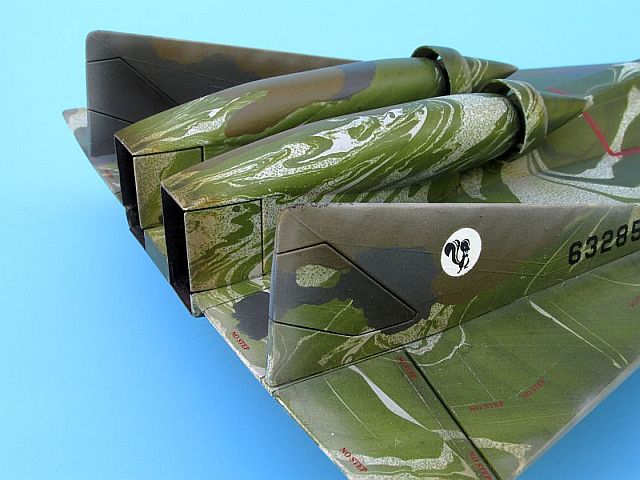Testor's 1/72 scale
XR-7 Thunder Dart
by Piotr Dmitruk
 |
XR-7 Thunder Dart |

HyperScale is proudly supported by Squadron
History (Slightly Alternative)
 "Loud pulsing sounds…loud enough to vibrate your body. Donuts-on-a-rope contrails in the sky. Hypersonic speeds exceeding Mach 7. A sharp triangular shape. And a large plane similar to the SR-71 also seen in the air”- such images according to eyewitnesses, were seen in the distant desert regions of Nevada, in the eighties. "Loud pulsing sounds…loud enough to vibrate your body. Donuts-on-a-rope contrails in the sky. Hypersonic speeds exceeding Mach 7. A sharp triangular shape. And a large plane similar to the SR-71 also seen in the air”- such images according to eyewitnesses, were seen in the distant desert regions of Nevada, in the eighties.
Still shrouded in an aura of secrecy, some have called the project Aurora, the other call it Senior Smart/Senior Citizen system, and informally by the Lockheed Skunk Works staff- XR-7 Thunder Dart.
It can be launched from the back of SR-75 and allow to achieve speeds of Mach = 7. Aircraft was equipped with classic turbojet engines, fuelled with JP-7, located at the bottom of the fuselage, which were turned off at high speeds and the air intakes were closed by a flaps. Then the aircraft was powered by Pulse Detonation Wave Engines powered by liquid methane. In liquid form, it was first used to cool the leading edge of the airframe, then directed to the heat exchanger in the rear part of the fuselage (hence the distinctive tooth-shape), then the gas was ignited by the laser beam. Power output was controlled by the frequency of laser pulsing. On the idle, pulse frequency was 30 cycles per second. The engine was very noisy and causing problems in the field of aeroacoustic durability of materials used, hence probably the decision to abandon the project. Another factor in achieving high-speed, but also generating problems was the use of ceramic materials on the leading edges. Despite of cooling, they warmed up to 3500 - 5000 degrees Fahrenheit, and probably required to be replaced after each flight at high speeds. To ensure the safety of the pilot, the whole front part of the plane was blown away in emergency, and as a little glider was to provide controlled flight and to allow the use of conventional ejection seat. Not without significance for the project was the cost of the a ground-based infrastructure, providing to hide starting vessels from prying eyes, and capable of the safe storage of large amounts of liquid gas.

End of the Cold War resulted in completion of financing for the project.
Aircraft was originally painted uniformly black, not due to mask the aircraft, but to facilitate heat radiation. During tests it appeared that due to the presence of hot plasma around the aircraft, it was not very effective. For a change it became important to hide the aircraft on the way back from reconnaissance mission at relatively low speeds and altitudes, after the fuel-consuming hypersonic flight. Lockheed developed the highly effective "swirl camouflage". Unfortunately, its application turned out to be very costly and little durable paint was used, causing discoloration and peeling. Therefore, this camouflage, despite its advantages, was not wide-spread in the USAF.
The Kit
Quite an old kit by Testors, even despite of positive panel lines, was quite pleasant in construction. It required only filling of large cavity on the fuselage back, matching of a beak, and improving the leading edge. Built almost straight out of the box, the only aftermarket product was the resin pilot's seat. Model was built for test-making of a "swirl camouflage ".
Do not take this model as my peak achievement, but I invite you to look at.
Please, enjoy!
Model, Images and Text Copyright ©
2013 by Piotr Dmitruk
Page Created 12 August, 2013
Last Updated
12 August, 2013
Back to HyperScale Main Page

|
Home
| What's New | Features | Gallery | Reviews | Reference | Resource Guides | Forum |